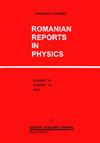BURAR地震台站微震和高频域地震噪声分析
IF 2.2
4区 物理与天体物理
Q2 PHYSICS, MULTIDISCIPLINARY
引用次数: 0
摘要
“在没有地震的情况下,地震台站会持续记录地球的振动,称为环境地震噪声(ASN)。ASN记录的主要关注点是使用专门为此目的开发的不同工具来提高地震数据质量。功率谱密度(PSD)及其相应的概率密度函数(PDF)是用来评估台站性能和揭示台站现场噪音水平的工具。高频(>1 Hz)噪声源来自文化活动,呈现日变化;低频(<1 Hz)噪声源来自自然,呈现季节变化。本研究分析了布科维纳阵地震台网(BURAR)的垂直分量,以表征台站的噪声水平,并研究噪声在空间和时间上的变化。我们计算了一些阵列元素的四年谱图,发现在温暖的季节,与寒冷的月份相反,ASN在2-5 Hz频率范围内增加。另一方面,在较低的频率(0.5-1 Hz),地震噪声的功率在一年中较冷的月份增加。我们研究了地震传感器与气象站配置的站点的噪声水平与天气参数(例如风速)之间的关系。我们观察到,风速的增加导致高频噪声水平的增加(>2 Hz)。”本文章由计算机程序翻译,如有差异,请以英文原文为准。
Seismic noise analysis in the microseismic and high-frequency domain at the BURAR seismic stations
"In the absence of earthquakes, seismic stations continuously record the Earth's vibrations, called ambient seismic noise (ASN). The main concern regarding the ASN records is improving the seismic data quality using different tools developed especially for this purpose. Power Spectral Densities (PSD) and their corresponding Probability Density Functions (PDF) are tools used to evaluate the station performance and reveal the noise level at the station’s site. For high frequencies (>1 Hz), the noise sources are from cultural activities and show diurnal variation, while for low frequencies (<1 Hz), the noise is generated by natural sources and shows seasonal variation. In this study, we analyzed the vertical components of the Bucovina array seismic network (BURAR) to characterize the noise levels at the stations and investigate noise variations in space and time. We computed four-year spectrograms for some elements of the array that revealed an increase of ASN in the 2–5 Hz frequency range during the warmer seasons, contrary to the colder months. On the other hand, at lower frequencies (0.5–1 Hz), the power of seismic noise increases during the year’s colder months. We examined the relationship between noise levels and weather parameters (e.g., wind speed) for the station where the seismic sensor is collocated, with a weather station. We observed that an increase in wind speed leads to an increase in the noise level at high frequencies (> 2 Hz)."
求助全文
通过发布文献求助,成功后即可免费获取论文全文。
去求助
来源期刊

Romanian Reports in Physics
物理-物理:综合
CiteScore
4.20
自引率
29.60%
发文量
0
审稿时长
4-8 weeks
期刊介绍:
Romanian Reports in Physics is a journal publishing physics contributions in the fields of:
1. Mathematical and General Physics
2. Nuclear Physics. Particle Physics. Astroparticle Physics
3. Atomic and Molecular Physics
4. Plasma Physics
5. Condensed Matter
6. Optics & Quantum Electronics
7. Biophysics & Medical Physics. Environmental Physics
8. Physical Methods and Instrumentation
9. Earth Physics
 求助内容:
求助内容: 应助结果提醒方式:
应助结果提醒方式:


